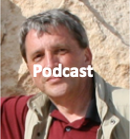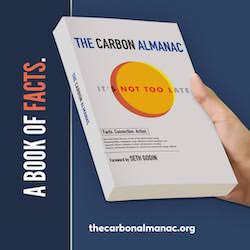by Gary Mintchell | Nov 9, 2022 | Automation, Capital Projects, News, Process Control
Taking environmental issues and carbon reduction out of the political arena and placing among those who can actually do something promotes good stewardship—and good business. Check out The Carbon Almanac (click the photo on the web page). This book contains a wealth of facts and action items for us all.
The major automation technology providers have invented and unleashed many ways customers can reduce carbon footprint. This research from ABB shows how offshore companies can reduce global carbon emissions by 300,000 tons per site per year, the equivalent of taking 150,000 cars off the road.
- Moving to autonomous operations increases reliability and predictability of energy supply
- Annual savings of up to $30 million can be achieved
ABB has published another of its ‘Energy Transition Equation’ reports that shows how industrial customers can reduce carbon emissions and manage the energy transition for a more sustainable future.
Based on nine months of research and modelling, the report highlights how early adoption and integration of automation, digitalization, and electrification technologies to enable autonomous operations can deliver savings of over 300,000 tons of carbon emissions per annum for offshore sites (approximately 25 percent reduction). This is the equivalent of removing 150,000 combustion cars from the road and is the same volume of CO2 responsible for five million tons of glacier mass lost each year.
The report also demonstrates how companies can realize production efficiencies of up to $30 million in annual savings, while delivering net revenue increases of up to $120,000, thanks to autonomous operations.
A key part of this is redeploying companies’ offshore workforces, moving them from hazardous roles into new ones onshore. In doing so, employers can offer safer working environments, a better work-life balance and fill industry talents gaps by reskilling employees to support a data-led approach to oil and gas exploration and production.
In 2021, ABB reduced its own CO2 emissions by 39 percent as part of its Sustainability Strategy 2030 and expects to be fully carbon neutral by decade’s end. The strategy details how ABB will support its global customers in reducing their annual CO2 emissions by at least 100 megatons by 2030, the equivalent of removing 30 million combustion cars from the roads.
The report’s economic modelling was undertaken by independent economist Steve Lucas of Developmental Economics, in conjunction with ABB Energy Industries and supported with desktop research of academic and industry sources. ABB will publish reports focused on the power and chemicals markets in 2023.
Notes to editors
These figures are based upon hypothetical scenarios of a 1 x 150000 barrel a day (oil) FPSO and a 1 x 150000 barrel (oil) Fixed Platform. Both assume an operational life cycle of 15 years with a 5-year development phase. Some have been rounded out for the purpose of the press release – exact calculations and figures can be found in the report or can be downloaded here.
by Gary Mintchell | Aug 9, 2022 | Automation, Capital Projects, Process Control
Sustainability continues its strong trend among industrial and manufacturing companies. This story concerns Emerson and Albioma regarding biomass.
Global technology and software company Emerson has been selected by Albioma, a French independent energy provider, to help transition its coal-fired Bois Rouge plant to 100% renewable energy. As part of Albioma’s wider mission to transition all of its existing fossil fuel plants to renewable energy, Emerson’s automation systems and software will enable the coal-fired power station to convert to biomass feedstock.
The multi-million-dollar project is the latest example of how Emerson technologies are helping customers accelerate their transition to more sustainable energy. The power plant, one of three that Albioma operates on Réunion Island in the Indian Ocean, will be converted to use 100% biomass wood pellets. The overhaul of the 108-megawatt facility will reduce greenhouse gas emissions by approximately 640,000 tons of CO2 equivalent per year, an 84% decrease in direct emissions compared to current operating levels.
The Bois Rouge plant consists of three generating units. Two units are already controlled by Emerson’s Ovation™ distributed control system, which will be modified for use with biomass feedstock, and the third unit will be replaced with a new Ovation system. The units will also be modernized with new turbine protection and health monitoring systems, safety systems for the boilers, and upgraded boiler control elements and instrumentation.
To ensure the project is completed within the available timeframe – a critical requirement of Albioma – Emerson will provide its Project Certainty methodologies, digital technologies and software expertise. In addition to delivering local engineering support for the project, Emerson will provide its Remote Virtual Office (RVO) collaboration platform – a secure virtual engineering and testing environment that will enable Albioma to access Emerson’s resources and ongoing support to reduce project risk and costs.
by Gary Mintchell | Jul 14, 2022 | Capital Projects, Commentary, News, Process Control, Technology
Technology pundits have extolled hydrogen as an energy source that makes sense from environmental and sustainable points-of-view for many years. Emerson recently hosted an online conference focused on what it is doing to help customers develop hydrogen production. We are finally on the cusp of a breakthrough. One problem hydrogen shares with electricity is dirty generation. Emerson and customers are working to solve the tech and economics of green hydrogen production.
While we are talking sustainability, please check out The Carbon Almanac. Hundreds of volunteers from around the world have worked on this practical guide to doing something about global warming and environmental dangers.
I’m going to summarize three sustainability initiatives from Emerson that I have collected for a few weeks.
- Toyota Hydrogen Production
- Green Hydrogen Production
- Biofuel Production in Finland
Automation Technology for Toyota Australia’s Hydrogen Production and Refueling Plant
Emerson and Toyota Australia have collaborated to transform part of Toyota Australia’s operations into a commercial-grade hydrogen production, storage and refueling plant. The project, supported by the Australian Renewable Energy Agency (ARENA), adopts Emerson’s automation expertise to provide the control system that helps Toyota Australia demonstrate the technical and economic feasibility of manufacturing hydrogen fuels, including the use of renewable solar energy.
- DeltaV distributed control system gathers data from the plant’s complex equipment
- DeltaV systems control operations and help ensure safe operations
- Edge control technology from PACSystems will further reduce cost and complexity of integrating third-party systems
- Rosemount flame detectors will help keep personnel and operations safe
Emerson to Help Accelerate Green Hydrogen Production
The PosHYdon project is a pilot that aims to validate the integration of offshore wind power and offshore natural gas and hydrogen production at sea—generating renewable fuels by harnessing a green energy source. The Neptune Energy-operated platform Q13a-A in the Dutch North Sea will host the project, which will provide insight into electrolyzer efficiency from a variable power supply and the cost of installing and maintaining a green hydrogen production plant on an offshore platform.
Green electricity will be used to simulate the fluctuating supply from wind turbines and power the production process, which will convert sea water into demineralized water and then safely produce hydrogen via electrolysis. The hydrogen is then blended with the natural gas and transported to the coast, via the existing gas pipeline, and fed into the national gas grid. The 1 MW electrolyzer is expected to produce up to three tons of hydrogen per week.
Emerson’s DeltaV distributed control system, DeltaV safety instrumented system and DeltaV Live operator interface software will manage the desalination and electrolyzer units, gas blending and balance of plant equipment.
PosHYdon is being developed by consortium partners Nexstep, TNO, Neptune Energy, Gasunie, Noordgastransport, NOGAT, DEME Offshore, TAQA, Eneco, Nel Hydrogen, InVesta, Hatenboer, Iv-Offshore & Energy and Emerson. The project has been awarded a €3.6 million grant from The Netherlands Enterprise Agency (RVO) under the agency’s Demonstration Energy and Climate Innovation scheme, which invests in renewable energy developments, including hydrogen pilots.
Animated video with English subtitles.
Optimize Fintoil Biorefinery Operations for More Efficient, Sustainable Production
Fintoil, together with Neste Engineering Solutions, has selected Emerson’s automation software and technologies to maximize the operational performance of its biorefinery being constructed in the port of Hamina-Kotka, Finland. The plant will be the third-largest crude tall oil (CTO) biorefinery in the world and produce advanced biofuel and biochemical feedstocks that help lower emissions and reduce reliance on fossil-based fuels.
The plant will refine CTO, a by-product of the wood pulping process, to produce a sustainable feedstock for renewable second-generation diesel, as well as rosin, sterol pitch and turpentine used in the chemicals, foodstuffs and pharmaceuticals industries. These CTO derivatives have a carbon footprint up to 90% smaller than their fossil-based equivalents.
Emerson will apply its Project Certainty methodology, which digitalizes project execution and uses practices such as remote testing of equipment. Emerson consultancy services will advise on the implementation of cybersecurity best practices.
Construction of the facility is expected to be completed in 2022. The expected annual capacity of 200,000 tons will create a 400,000-ton reduction in carbon dioxide emissions, which is roughly 1% of Finland’s total emissions.
by Gary Mintchell | May 20, 2022 | Automation, Business, Capital Projects
Seth Godin initiated a project that has enlisted many volunteers from many countries called The Carbon Almanac. You can get yours soon. I thought I could contribute from the point of view of manufacturing and industrial production. I couldn’t get any information in time to contribute. However, I have had a couple of sustainability reports in the past month. Here is one from Phoenix Contact which has installed a nearly 1-megawatt array that will produce 30% of facility’s energy needs.
“We estimate this solar power installation will reduce our electricity costs by approximately $150,000 per year. While a smart business choice for us, reducing our company’s carbon footprint is more important in the long term,” said Jack Nehlig, president of Phoenix Contact USA. “Sustainability and renewable power generation are at the heart of Phoenix Contact’s vision for an All Electric Society. This is one critical step on our journey to becoming a carbon-neutral company by 2030.”
Phoenix Contact partnered with Gatter & Diehl Consulting Engineers and Terrasol Energies, Inc. to design the rooftop solar array. Phoenix Contact designed and installed the monitoring portion of the system, which features numerous Phoenix Contact products.
Terrasol Energies, Inc. also installed the solar array on the roof of Phoenix Contact’s Logistics Center for the Americas last year. The solar array consists of 2,185 SunPower photovoltaic panels, which can generate up to 961 kilowatts. A $250,000 PEDA restart grant and a $270,000 grant from the PPL ACT 129 fund helped offset the $1.8 million investment into the solar array.
In 2014, Phoenix Contact installed a 1-megawatt Combined Cooling Heating and Power (CCHP) facility. The system provides 65 percent of the facility’s energy needs and saves the company more than $300,000 annually. With the CCHP and the solar array, Phoenix Contact will generate enough energy to go off the grid on sunny days during the shoulder seasons (spring and fall).
by Gary Mintchell | May 16, 2022 | Capital Projects
That 2,800th post was not supposed to be the last for a while. I had an attack of seasonal allergies that sapped all my energy for several days. Finally about back to normal. I know about wearing masks for Covid and flu prevention. Seasonal allergies (pollen) are another good reason to wear a mask.
Speaking of the environment (OK, this is bad segue) I have a news item that came a couple of weeks ago relative to the circular economy. That is, reusing products we’d otherwise dispose of in a toxic manner. Here is a company called Assurant that just acquired Hyla and its sustainability in manufacturing activities. It has several plants that refurbish mobile phones for trade-ins.
**I’d like to plug a project at this point that I thought I’d get involved in to write from a manufacturing point of view. The Carbon Almanac tells stories and gives tips for saving the planet. Check it out. Spread the word.**
More than ever, the output from our circular economy – a systems framework that addresses global environmental challenges including waste and pollution – continues to have a markedly positive effect on our planet. Within that, businesses who prioritize CSR by mitigating e-waste through responsible recycling of mobile devices have contributed a significant impact to this positive outcome.
Just a couple of years ago, the extent of the relationship consumers had with their carrier or retailer was limited to purchasing add-ons to their current service in the vein of an upsell model. But the consumer needs often ended there in terms of any additional requirements. Fast forward to 2022: now the consumer wants to know just where the phone goes when they’re done with it. 3G sunsetting is now shining a light on new opportunities for CSR when it comes to sustainability and if carriers and retailers do not take note, it is a missed opportunity. By the end of 2022, the majority of wireless carriers will either have already completed the process of shutting down, or sunsetting, of their 3G networks or will have started the process of doing so.
Technology and Processing (TaP) Center is the nucleus of its operations, as it is the place where pre-owned devices are received, graded and resold into the global secondary device market.
The TaP Center receives and processes over six million devices per year, and this figure is set to rise as continuous innovations and efficiency gains drive increased demand on the facility.
The TaP Center facilitates the end-to-end processing of pre-owned devices efficiently. These steps include:
- Device receipt and validation
- Device identification
- Data clearing
- Functional testing
- Cosmetic grading
- Repairs
- Parts salvaging
- Warehousing/inventory management
- Device resale
- Sustainability management
Furthermore, the secondary device market is one that continues to grow and has displayed its resilience even despite the COVID-19 pandemic. While IDC reports that the worldwide market for secondhand devices will be worth $65 million by 2024, with a compound annual growth rate of 11.2% over the next three years, Gartner found a 24% increase in refurbished phone sales during the first quarter of 2020.
The patent pending HYLA Vision Tunnel was developed for cosmetic grading. Unlike other grading and processing technology, it has been designed by those working in industrial and manufacturing environments, which means it has been built with speed and simplicity in mind, and adapted to the needs of this specific industry. Vision Tunnel is also designed with operational efficiency in mind with virtually no training required for in-warehouse personnel.
Vision Tunnel uses AI technology to evaluate and analyze each device. It will take up to seven images of each pre-owned device to determine its grade. This means HYLA has over 1,000,000 high quality 4K images that it uses to continuously train its AI technology, which ensures it grades devices with 99% accuracy.
The beauty of Vision Tunnel is that it simplifies and speeds up device processing. It minimizes manual labor, which means it is less prone to human error, while at the same time delivering consistent and reliable results
by Gary Mintchell | Aug 30, 2021 | Capital Projects, Leadership, Workforce
Working on the factory floor early in my career taught me how much typical manufacturing workers know and care about the company’s products. Consultants came from time to time, studied, rearranged, left. Not much useful happened. But the individual guys (in those days) on the line knew more about what was going on than most of the supervisors and all of management.
Therefore, an opportunity to talk with Paul Vragel, Founder and President of 4aBetterBusiness in Evanston, IL to discuss his experiences as a project engineer and integrator was too good to pass up. After all, the values he learned and still implements include these:
- Listen to people
- Engage employees
- Respect
- Ask everyone to look for problems with no fault issued
- Assume employees have needed knowledge
Vragel told me, “My initial education and experience is in Naval Architecture and Marine Engineering – that is, ship design and construction. Building a ship involves building a hotel, a restaurant, a huge warehouse and a power plant, putting them all together, putting a propeller on it and sending it out on the ocean where there are no service stations. Ship design and construction is essentially a demanding, large-scale systems engineering project.”
After graduation from Webb Institute of Naval Architecture, he worked at Newport News Shipbuilding. After a year, 2 prior graduates of Webb Institute, working for Amoco Corporation, hired him, at the age of 22, to manage ship construction programs in Spain. “A couple weeks after I was hired, I was on a plane to Spain with my instruction set being, essentially, ‘figure out what you’re supposed to do, and do that’ ”.
After a year, one of the earlier ships built in the series came in to Lisbon for its guarantee drydocking and inspection. When we opened one of the crankshaft bearings of the 30,000 hp main diesel engine, we saw the bearing material, which was supposed to be in the bearing, was lying on the crankshaft journal, in pieces.
Talk about a complex situation—the ship was built by a company controlled by the Spanish Government. They were the holder of the guarantee. The engine was built by a different company, also controlled by the Spanish Government. Amoco had a contract with the shipyard, not the engine builder. And the engine was built under license from a company in Denmark.
Vragel was there as an observer for the new construction department. The ship was under the control of the operations department. I had no authority and no staff reporting to me. “I had no technical knowledge of poured metal bearings in high-powered diesel engines, I didn’t speak Portuguese or Spanish, I was 23 years old, and the instruction from my boss was very simple: ‘Fix It!’ To add to the urgency of the ship being out of service, the shipyard in Lisbon, where the ship was located, was charging $30,000/day (about $250,000 in today’s dollars), just for being there.”
Vragel went to the engine builder in Spain who said, “We don’t think we have a problem – we think the Danes have a problem. They designed the engine, we just built it according to their instructions.”
Figuring that getting the Danish engineers down to Spain for a meeting wouldn’t be productive, he decided the only thing to do was to go into the plant and talk to the people who made the bearings. One problem – they only spoke Spanish, and he only spoke English. But there are lots of ways to communicate if you really want to. “I observed what they were doing, pointed, asked a lot of questions – they learned a little English, I learned a little Spanish – and we sketched out how the bearings were made.”
After a couple of days, he thought he had figured out the cause of the problem, but “I had the good sense to shut up. While our communication had become pretty good, I was sure that there were other parts of the process they knew about that we hadn’t touched on that might be part of the problem or solution. If I just told them what I thought, everything would stop there without awareness of those elements and we wouldn’t get an effective solution. But if I could work with them through the process so they saw the issues, the employees would bring those additional elements to the table. We would have a full understanding of the system, the employees would be part of the solution. In this way, employees would have ownership in the results.”
“And that’s exactly what happened. With a little more effort we found and fixed the causes of the problem (which was causing porosity in the bearing).”
I had no authority, no technical expertise, no staff, I was 23 years old, I didn’t speak Portuguese or Spanish, and in a few days, working cross language and cross culture in an overseas plant I had never seen in a technology in which I had no experience, we together achieved a solution that permanently raised their manufacturing capability – that they owned.
This key formative experience led to the beliefs on which 4aBetter Business was founded:
- We believe that employees are the world’s experts at knowing what they actually do every day – their local systems
- We believe that 90% of the issues in a company are embedded in the way these local systems work and work together
This lesson applies to 22-year-olds and 52-year-olds alike. Sometimes we get so wrapped up in our own ideas that we overlook an obvious source of great expertise.





